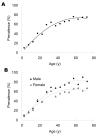Seroprevalence of hepatitis E virus infection, rural southern People's Republic of China
- PMID: 17283617
- PMCID: PMC3372335
- DOI: 10.3201/eid1211.060332
Seroprevalence of hepatitis E virus infection, rural southern People's Republic of China
Abstract
Genotype 4 hepatitis E virus (HEV) is the dominant cause of hepatitis E in the People's Republic of China; swine are the principal reservoir. Our study was conducted in 8 rural communities of southern China, where families keep pigs near their homes. Phylogenetic analysis showed that 23 of 24 concurrent virus isolates from this region are genotype 4 strains. Among the study populations, immunoglobulin G anti-HEV seroprevalence accumulated with age at approximately equal to 1% per year for persons < or =60 years of age. After age 30 years, seroprevalence increased at higher rates for male than for female study participants. The overall seroprevalence was 43% (range 25%-66%) among the communities. Infection rates were higher for participants between 25 and 29 years of age. The results suggest that HEV infection probably has been endemic in southern China for at least 60 years, with swine being the principal reservoir of human HEV infection in recent years.
Figures



Similar articles
-
Identification of genetic diversity of hepatitis E virus (HEV) and determination of the seroprevalence of HEV in eastern China.Arch Virol. 2007;152(4):739-46. doi: 10.1007/s00705-006-0882-0. Epub 2006 Nov 27. Arch Virol. 2007. PMID: 17131064
-
Seroprevalence and distribution of hepatitis E virus in various ethnic groups in Gansu province, China.Infect Genet Evol. 2010 Jul;10(5):614-9. doi: 10.1016/j.meegid.2010.04.003. Epub 2010 Apr 14. Infect Genet Evol. 2010. PMID: 20398803
-
Seroepidemiology of hepatitis E virus infection in 2-25-year-olds in Sari district, Islamic Republic of Iran.East Mediterr Health J. 2009 Jan-Feb;15(1):136-42. East Mediterr Health J. 2009. PMID: 19469436
-
Seroprevalence and molecular detection of hepatitis E virus in Yunnan Province, China.Arch Virol. 2011 Nov;156(11):1989-95. doi: 10.1007/s00705-011-1089-6. Epub 2011 Aug 28. Arch Virol. 2011. PMID: 21874521
-
[Recent advances in the epidemiological research on hepatitis E in China].Zhonghua Liu Xing Bing Xue Za Zhi. 2010 Dec;31(12):1414-6. Zhonghua Liu Xing Bing Xue Za Zhi. 2010. PMID: 21223677 Review. Chinese. No abstract available.
Cited by
-
Monitoring of Anti-Hepatitis E Virus Antibody Seroconversion in Asymptomatically Infected Blood Donors: Systematic Comparison of Nine Commercial Anti-HEV IgM and IgG Assays.Viruses. 2016 Aug 22;8(8):232. doi: 10.3390/v8080232. Viruses. 2016. PMID: 27556482 Free PMC article.
-
Molecular epidemiology of hepatitis E virus infections in Shanghai, China.Virol J. 2011 Dec 15;8:541. doi: 10.1186/1743-422X-8-541. Virol J. 2011. PMID: 22168371 Free PMC article.
-
Changes and Clinical Significance of PIVKA-II in Hepatitis E Patients.Front Public Health. 2022 Jan 25;9:784718. doi: 10.3389/fpubh.2021.784718. eCollection 2021. Front Public Health. 2022. PMID: 35145947 Free PMC article.
-
Baseline antibody level may help predict the risk of active human cytomegalovirus infection in a HCMV seropositive population.Eur J Clin Microbiol Infect Dis. 2017 May;36(5):863-868. doi: 10.1007/s10096-016-2873-8. Epub 2016 Dec 28. Eur J Clin Microbiol Infect Dis. 2017. PMID: 28032284
-
The Bama miniature swine is susceptible to experimental HEV infection.Sci Rep. 2016 Aug 18;6:31813. doi: 10.1038/srep31813. Sci Rep. 2016. PMID: 27534702 Free PMC article.
References
Publication types
MeSH terms
Substances
LinkOut - more resources
Full Text Sources
